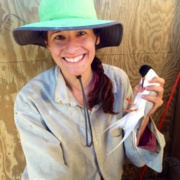The sky's limit: Making aerial wildlife surveys reliable
When Kayla Davis went to the Gulf of Mexico to collect data to help estimate the abundance and distribution of different marine birds, she ended up on a different quest. After witnessing surveyors’ difficulties counting individual birds from the air, Davis decided to change her focus and begin an investigation into aerial data collection methods.
“You start out doing one thing and then you realize the methods behind what you are doing could be refined or made better,” said Davis, a Michigan State University (MSU) PhD student in the Zipkin Quantitative Ecology Lab. “I couldn’t find a synthesis on the challenges of analyzing aerial survey data. So hopefully, this new research will be a useful tool for those using aerial survey data to understand wildlife patterns.”
The paper, “Errors in aerial survey count data: Identifying pitfalls and solutions,” was recently published in the journal Ecology and Evolution. Davis and her team worked in collaboration with the U.S. Fish and Wildlife Service and the U.S. Geological Survey.

“Aerial surveys are often the best approach for collecting data in vast or remote landscapes”, says senior author Elise Zipkin, associate professor in the Department of Integrative Biology in the MSU College of Natural Science, and director of the Ecology, Evolution, and Behavior Program. “However, analyses of aerial surveys can easily lead to biased inferences of wildlife abundance if not careful, because there are several confounding factors affecting the detection of species and individuals.”
Wildlife policy and management decisions often rely on estimates of animal abundance, so inaccurate counts can have negative consequences, especially with rarer species. Biased information can seriously misinform policy decisions such as where to place energy farms or where to dig for oil and gas. Reliable analyses of aerial surveys can lead to better decisions for wildlife and the environment.

The team used a three-pronged approach to tackle the problem. They analyzed waterbird data from the Gulf of Mexico Marine Assessment Program for Protected Species (GoMMAPPS), evaluated the literature on aerial surveys from the last 50 years, and created an online flock-counting quiz, which they administered to about 100 trained aerial observers.
Davis and her colleagues identified three major detection errors with aerial surveys: non-detection, the failure to count animals that are present; counting error, when group size is counted inaccurately; and misidentification, incorrectly identifying species. Each of these issues can lead to biases in wildlife estimates. For example, when a survey is focused on multiple species, it often resulted in an over-count of one species and an undercount of another.
In addition, the online survey revealed that observers tended to undercount flock sizes, even at small group sizes (less than 30 individuals), but that the margin of error increased as the group size increased, sometimes off by as much as 50 percent.
“A good first step when designing an aerial count survey, is to determine which issues are probable under given survey conditions,” Davis said. “If the target is a single, solitary species, non-detection may be the major source of bias. However, when similar-looking species aggregate such as in our GoMMAPPS case study, all three detection errors should be carefully considered.”
Read the story in the College of Natural Science.



